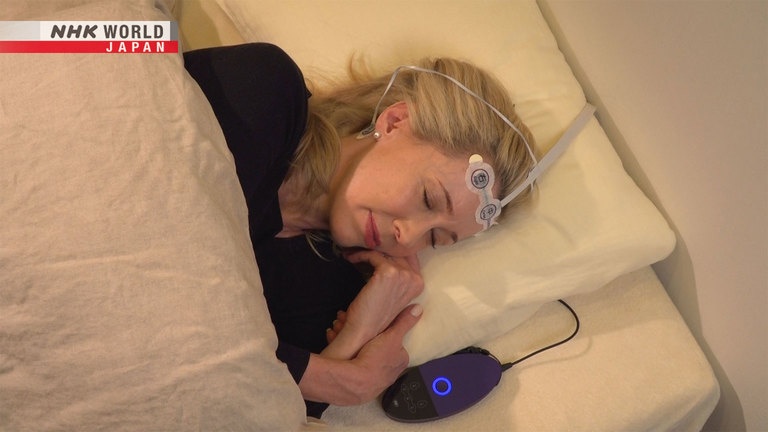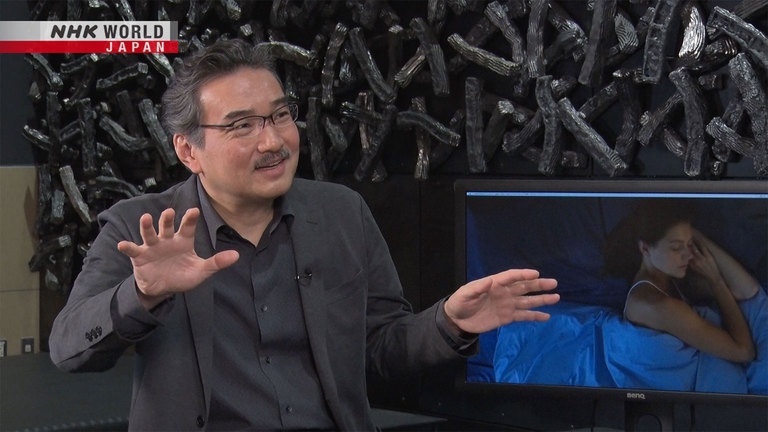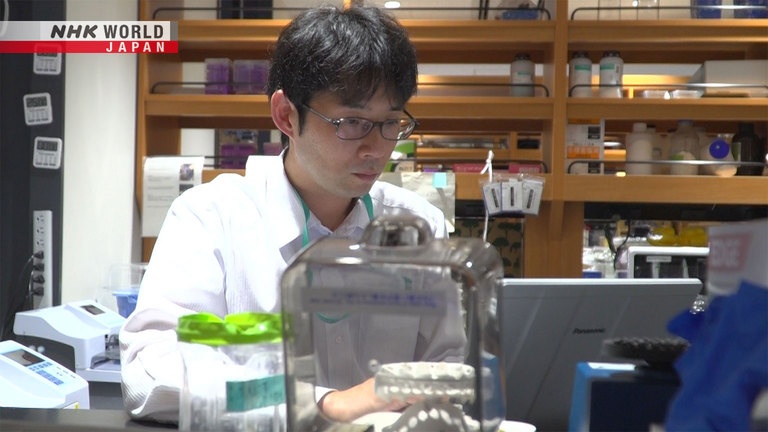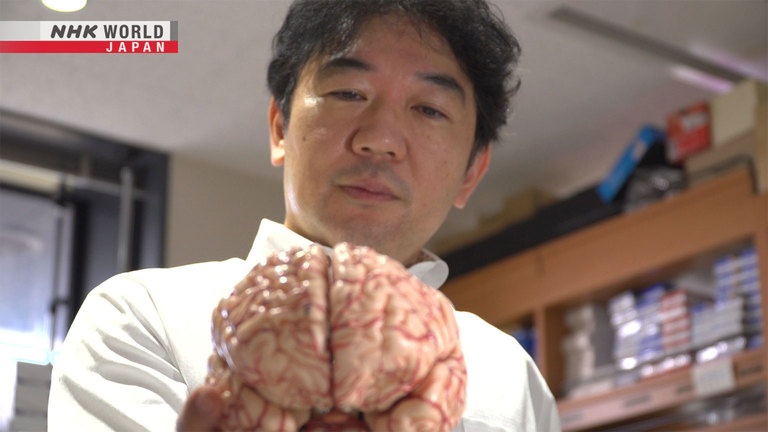Exploring the Mystery of Good Sleep
Sleep is said to be the biggest black box of modern science. The International Institute for Integrative Sleep Medicine in Japan is known for its global contributions to uncovering the mysteries of sleep. It developed a device that can be used at home to easily measure brain waves during sleep and analyze sleep quality. Research has revealed the importance of REM sleep, during which the brain becomes highly active, and found a lack of it is associated with a higher risk of dementia and obesity.




Transcript
Join us as we explore Medical Frontiers.
An international survey conducted by Oxford University and others in 2020 on the populations of 13 countries found
that almost 40% suffered from insomnia during the first wave of the COVID-19 pandemic.
I'm certainly no stranger to it either.
Today, we are going to delve into the mysteries of sleep,
and the difference between good sleep and bad sleep.
Why do animals need sleep?
And what are the functions of sleep?
Sleep is said to be the biggest mystery of modern science.
IIIS is a research institute near Tokyo
that's world-renowned for its contributions to uncovering the mysteries of sleep.
Professor Yanagisawa, it's so lovely this you to great honor and thank you so much for today.
Did you see the pigs?
Gosh, it's a spectacular.
Yeah, it's actually sleeping.
Sleeping and you know, dreaming about flying.
They look very happy, very happily sleeping.
Mother and piglet.
Masashi Yanagisawa is the director of IIIS.
He's a world-class researcher who discovered a brain substance related to sleep and waking.
And he has received many international awards.
We developed this type of device.
You know it's very floppy.
It's a printed electrodes...
In 2020, Yanagisawa and his team developed a small device
that people could use at home to easily measure brain waves during sleep.
So you actually already tested, right?
I did it.
Professor, for three days.
Until now, to accurately measure brain waves during sleep,
it was necessary to stay at a hospital and wear numerous electrodes.
However, measurements can be taken easily with this device
by sticking the adhesive electrodes on the forehead and behind the ears.
There are only a few electrodes, but combining the information from them makes it possible to gather the necessary data.
Starting measurement. Good night.
Artificial intelligence automatically analyzes the brain waves and determines the stage of sleep every 30 seconds.
The team is currently waiting for the government to approve this as a medical device.
Good night.
We measured the brain waves of one of our staff.
Let's look at his data to learn about the mechanism of human sleep.
This graph, called a hypnogram, shows the stages of sleep.
Sleep is divided into 2 states: REM and non-REM.
The black bars at the top show the periods of awake time.
The red bars below indicate REM sleep.
These rapid eye movements during sleep is where the turn REM sleep comes from.
This form of sleep can also be described as the "dream state".
The three lines below indicate non-REM sleep, without rapid eye movement.
Non-REM sleep can be divided into three levels: N1, N2, and N3.
The larger the number, the deeper the sleep.
The balance between REM sleep and non-REM sleep is the key to good quality sleep.
At 11:45 p.m., soon after falling asleep, our staff member enters non-REM sleep,
during which there is little eye movement.
His sleep gradually deepens.
Twenty-five minutes later, he enters the deepest level of non-REM sleep.
During non-REM sleep, your breathing deepens and slows, and your heart rate decreases.
Forty-five minutes after falling asleep, the transition to REM sleep happens for the first time.
During REM sleep, your brain becomes highly active.
Breathing becomes shallow, and your heart rate rises.
Your eyes move rapidly during REM sleep because of vivid dreams.
No matter how real your dreams may feel, you don't act out your dreams.
This is a distinctive characteristic of REM sleep.
During REM sleep, our muscles
are completely relaxed.
So you've got zero basically contraction muscles.
REM sleep is a very special state.
There’s no input to the brain,
nor output to the body.
During REM sleep, the brain and the body are completely separated.
The brain is working actively, but the body is completely relaxed.
REM sleep is often shown up here,
so people think it’s shallow sleep.
Everyone does everyone. And obviously we assume it's like light sleep.
That’s not true. Judging from the stimulus
or sound needed to wake someone up,
REM sleep is about as deep as N2 or N3.
That's fascinating.
REM sleep is quite deep.
But it’s a very different kind of sleep.
Most people go through four to five cycles of non-REM sleep and REM sleep a night.
There is more the deepest non-REM than REM in the first half of sleep, and vice versa in the latter half.
This graph indicates good quality sleep.
This is what everyone says we sleep in 90 minutes' cycles, but is that also individualized?
There are individual differences,
and also variations in each person.
Here’s this person’s first cycle.
His second cycle is longer.
Completely different. This is what I'm saying on this.
Cycles fluctuate within each person.
I used the device for three nights.
I'm a little bit nervous to hear about my results.
So I'm thinking of probably no great.
But we'd love to see the results.
Here are the results of Erica's measurements for the three nights.
She usually goes to bed around 1:00 a.m.
and wakes up around 10:00 a.m.
You’re a night owl.
I 'm definitely, I 'm definitely not an early morning person.
But you have a regular sleep schedule.
The problem is you wake up every night
about 30 minutes after falling asleep.
So I have something called restless legs syndrome.
So I just get this sensation in my calves.
I have to get out of bed and then I stretch or I do a bit of yoga.
And then I go to sleep again.
The rest of your hypnogram looks good.
You have periods of deep sleep,
and your REM sleep isn’t too short.
Your sleep isn’t bad at all,
except for that period when you wake up.
So I just need to get rid of the black.
That’s right.
Non-REM sleep and REM sleep have different functions.
During the deepest level of non-REM sleep, the pituitary gland releases growth hormone.
That allows the brain to grow, and memories to take root.
There has been little progress in uncovering what happens in the brain during REM sleep.
Its functions were a mystery for a long time.
In recent years, researchers have published many studies that suggest the importance of REM sleep.
In 2017, a US research group published this paper about the relationship
between REM sleep and dementia.
It examined the proportion of REM sleep in a group of people over the age of 60 for three years,
then did a follow-up survey to see who developed dementia.
They discovered that each 1 percent drop in REM sleep
was associated with a 9 percent increase in the risk of developing dementia.
However, they didn't understand why people who had less REM sleep had a higher risk of dementia.
Yu Hayashi of the IIIS is trying to solve this mystery.
In 2021, in a world first, Hayashi and his team succeeded in capturing an image of blood flow in the brain of a sleeping mouse.
The team observed capillaries which form a mesh-like pattern inside the cerebral cortex.
Capillaries deliver oxygen and nutrients to the brain and collect waste.
The team observed the capillaries in the mouse's brain with a special microscope.
They found that blood flow nearly doubles during REM sleep.
I was excited when I first saw the data.
I became even more convinced that
REM sleep plays an important role.
This image, captured by Hayashi, shows the movement of red blood cells in the mouse's
cerebral cortex during non-REM sleep.
The dark lines represent their movement.
This image was taken during REM sleep.
There are many dark lines, indicating the movement of countless red blood cells.
This means there is an increased blood flow.
The difference between REM sleep and non-REM sleep is obvious.
The team also found that blood flow is higher during REM sleep than in the waking state.
We believe that REM sleep boosts
blood flow in the cerebral cortex.
It’s very important for refreshing the brain.
Without REM sleep, the cerebral cortex may
lack nutrients.
I think it might lead to a higher risk of
dementia and depression.
The IIIS has also published a study saying that a lack of REM sleep can lead to obesity.
Another research team at the institute prepared two groups of mice.
One group slept on soft sawdust, and the other slept on a wire mesh.
The mice that slept on the wire mesh couldn't rest well, and their REM sleep decreased.
The research team gave both group of mice sweet chocolate, fatty food and standard food.
Compared to the mice that got enough REM sleep,
the decreased REM sleep mice consumed more fat and sucrose which in found in sugar.
This scientifically proved that the lack of REM sleep can lead to obesity.
This team learned the importance of REM sleep.
Without enough REM sleep,
you crave sweet and fatty foods.
So they'll go straight for a donut or a pastry or a hamburger, for example, and fries.
REM sleep is important,
and you need a sufficient amount of it.
To get enough REM, you need to
get enough sleep in general.
As we saw in the graph, REM sleep
increases toward the end of the night.
If you wake up too soon or
don’t sleep enough, you’ll lack REM sleep.
You’ll end up with a "lack of REM."
I like that phrase.
However, the mechanism behind the transition from non-REM to REM sleep has been unknown.
Part of the mystery was uncovered by the vice director of the IIIS, Takeshi Sakurai.
Sakurai has spent many years studying narcolepsy, a disorder in which sufferers suddenly fall asleep.
One of the symptoms of narcolepsy is a sudden loss of muscle tone throughout the body, called cataplexy.
Losing such control is similar to what happens in REM sleep.
Sakurai believed that there was a trigger that was common to cataplexy in
narcoleptic patients and REM sleep in healthy people.
He discovered that trigger, and in March 2022, published his findings in Science magazine.
He demonstrated that a surge in the levels of a neurotransmitter called dopamine
triggers both cataplexy and REM sleep.
I knew I was right, and I remember talking
with colleagues about how interesting this was.
Sakurai checked dopamine levels in the mice's brains in an area called the amygdala.
It has been known to become activated during REM sleep.
He conducted an experiment on sleeping mice and narcoleptic mice.
He found that, right before the sleeping mice transitioned from non-REM to REM sleep, their dopamine levels spiked.
Narcoleptic mice also showed similar surges in dopamine levels right before cataplexy.
Many sleep disorders involve abnormal REM sleep.
They include narcolepsy and
REM sleep behavior disorder.
Our findings might help to develop
treatments for them.
This is what's so interesting, I mean, it could open up a whole new avenue for sleep medications
because most of them are, I mean, serotonin or melatonin or, certainly not dopamine.
It would be great if scientists could develop
a medicine which works like dopamine.
That would trigger REM,
so people could get more REM sleep.
So going forward, obviously the REM sleep is going to be a very very hot area.
A hot topic of sleep research.
Of course, it would be better to get good quality sleep without relying on drugs.
We asked Yanagisawa for suggestions.
People always ask me how to get good sleep.
I tell them to look at it the other way.
You can avoid doing things that
are bound to worsen your sleep.
Yanagisawa says there are three things that can lower sleep quality and should be avoided.
First, alcoholic drinks and caffeinated beverages such as coffee should not be taken before bed.
Caffeine can keep you from falling asleep.
Alcohol may help you fall asleep, but it could wake you up in the middle of the night.
Second, the light in your bedroom should be turned off.
It can disrupt your sleep, causing you to wake up before the morning.
Third, sleeping in on weekends has the negative effect.
Try to go to bed and wake up at the same time as you do on weekdays.
We asked the sleep researchers whether they get good-quality sleep.
Yes and no.
Unfortunately.
I don't have any major sleep issues.
I fall asleep quickly and manage to
stay asleep until the morning.
But I also said "no" because I have a
mild case of sleep apnea. I snore, too.
Sleep apnea lowers my score.
Well...I don’t think I get good-quality sleep.
I’m always busy with odd jobs.
You can’t go to bed when you want to?
No. It’s an eternal challenge
for university instructors.
Only humans desire good sleep.
Animals don’t think about that.
They have a healthy sleep and wake cycle.
Are you getting good sleep?
I’m not.
Does this sound familiar?
If so, we have some special tips for you.
So today on the program, we're joined by the lovely Miho, who is a pillow specialist.
Thank you for having me.
Mihashi Miho is a sleep advisor who is involved in developing sleep-related items.
She will explain how to select the right pillow.
How do we know how to choose the best pillow?
You should use a pillow that suits your body.
Your sleeping and standing posture should
be the same. Your pillow should fill the space
behind your head and neck.
They will look through Mihashi's pillow collection for the perfect one for Erica.
I've never seen what an unusual pillow it looks like Mickey Mouse.
What is this?
It looks like a bear at first, but turned
upside down, it makes a good pillow.
Erica tried this bear-like pillow first.
This pillow keeps your neck straight,
allowing you to breathe easily.
This is so much more comfortable than the pillow I have.
The sides of this pillow are slightly elevated.
This keeps your body straight and avoids burdening your shoulders when you lie on your side.
Next is Mihashi's recommendation for people who roll over often in their sleep.
Is that a pillow?
Yeah.
It's huge.
Oh, my gosh.
It's huge.
It's the size of the whole bed.
This pillow measures 27 by 35 inches, or nearly 70 by 90 centimeters.
It supports the upper body by filling in the gaps between the body and mattress from the head to the back.
No matter how many times you roll over, you can sleep comfortably.
The next pillow contains sheets that
let you easily adjust its height.
We asked Mihashi to adjust the pillow to the right height for Erica.
Which was most comfortable?
Actually, this is.
But it's interesting because it's so much lower than the one I usually use at home.
Here's the pillow that Erica uses at home.
It's a popular shape, with the highest point being at the center.
It elevates her head, causing her neck to protrude forward.
Mihashi says a pillow that keeps your neck straight will help you to breathe comfortably and sleep better.
Obviously overseas we don't have access to a lot of these incredible pillows.
Most of us have this one or maybe two of these style.
What else could we use, for example?
Let me show you how to
make a pillow with bath towels.
First, fold a bath towel into four.
The next step is the key.
Fold the towel again about 4 inches, or 10 centimeters, from the edge.
That's roughly the length of the neck.
Then fold the towel in half to create the center of the pillow.
If you need to adjust the height, put another towel underneath it.
Next, roll up two more bath towels that's been folded into four to make the sides.
The handmade pillow is complete.
You can put a face towel on top.
That's like origami.
The height looks good.
How do you like it?
Is actually quite comfortable surprising that it's towels.
And I think it's probably a really good height.
Mihashi says you can also sleep better if you use a cushion and a towel.
This is best for people who sleep on their sides.
Place your arm on a cushion and put a bath towel between your knees.
It's a simple way to correct distortion in your pelvis and helps you to sleep comfortably, even on your side.
This is very easy to do.
You tried several pillows today.
What did you think?
I love Kuma, bear pillow is so comfortable but I really realize that at home my pillows are far too high.
And I'm getting, you know, my neck goes out a lot and I have a lot of, you know,
really, really stiff, tight shoulder and neck.
Thank you so much today.
it's been really really eye opening and enlightening and so interesting so thank you.
Thank you!
There are still so many unknowns about sleep, but scientists in Japan,
who are the forefront of this research, are working to get one step closer
to uncovering the great mysteries behind sleep.
I very much hope they succeed so that insomnia sufferers worldwide are able to get some relief.
And tonight, I plan to use this pillow, which is perfect for me, to hopefully get some restful sleep.
Good night.